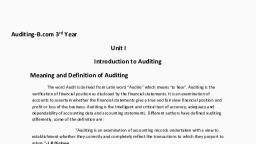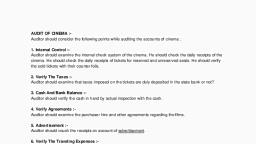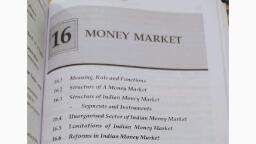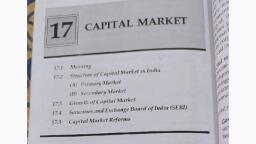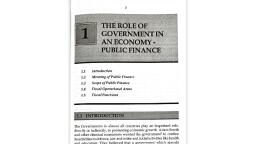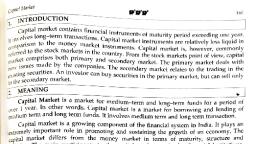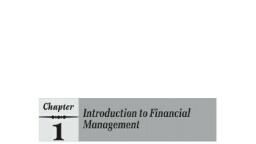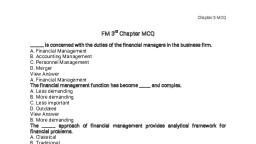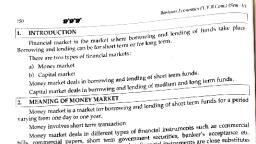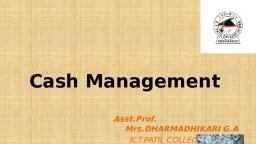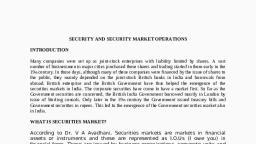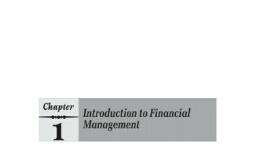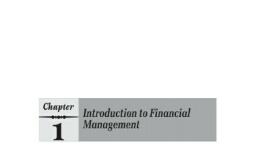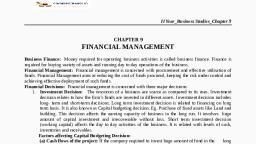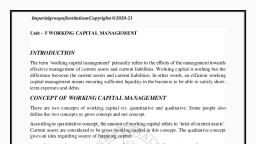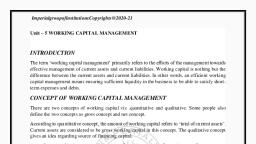Page 1 :
One of the most important finance functions is to intelligently allocate capital to long term assets. This, activity is also known as capital budgeting. It is important to allocate capital in those long term assets so, as to get maximum yield in future. Following are the two aspects of investment decision, a. Evaluation of new investment in terms of profitability, b. Comparison of cut off rate against new investment and prevailing investment., Since the future is uncertain therefore there are difficulties in calculation of expected return. Along with, uncertainty comes the risk factor which has to be taken into consideration. This risk factor plays a very, significant role in calculating the expected return of the prospective investment. Therefore while, considering investment proposal it is important to take into consideration both expected return and the, risk involved., Investment decision not only involves allocating capital to long term assets but also involves decisions of, using funds which are obtained by selling those assets which become less profitable and less productive., It wise decisions to decompose depreciated assets which are not adding value and utilize those funds in, securing other beneficial assets. An opportunity cost of capital needs to be calculating while dissolving, such assets. The correct cut off rate is calculated by using this opportunity cost of the required rate of, return (RRR), , Financial Decision, Financial decision is yet another important function which a financial manger must perform. It is important, to make wise decisions about when, where and how should a business acquire funds. Funds can be, acquired through many ways and channels. Broadly speaking a correct ratio of an equity and debt has to, be maintained. This mix of equity capital and debt is known as a firm’s capital structure., A firm tends to benefit most when the market value of a company’s share maximizes this not only is a, sign of growth for the firm but also maximizes shareholders wealth. On the other hand the use of debt, affects the risk and return of a shareholder. It is more risky though it may increase the return on equity, funds., A sound financial structure is said to be one which aims at maximizing shareholders return with minimum, risk. In such a scenario the market value of the firm will maximize and hence an optimum capital structure, would be achieved. Other than equity and debt there are several other tools which are used in deciding a, firm capital structure., , Dividend Decision, Earning profit or a positive return is a common aim of all the businesses. But the key function a financial, manger performs in case of profitability is to decide whether to distribute all the profits to the shareholder, or retain all the profits or distribute part of the profits to the shareholder and retain the other half in the, business., It’s the financial manager’s responsibility to decide a optimum dividend policy which maximizes the, market value of the firm. Hence an optimum dividend payout ratio is calculated. It is a common practice to, pay regular dividends in case of profitability Another way is to issue bonus shares to existing, shareholders., , Liquidity Decision, It is very important to maintain a liquidity position of a firm to avoid insolvency. Firm’s profitability, liquidity, and risk all are associated with the investment in current assets. In order to maintain a tradeoff between
Page 2 :
profitability and liquidity it is important to invest sufficient funds in current assets. But since current assets, do not earn anything for business therefore a proper calculation must be done before investing in current, assets., Current assets should properly be valued and disposed of from time to time once they become non, profitable. Currents assets must be used in times of liquidity problems and times of insolvency., , The Role of the Finance Function in, Organizational Processes, The Finance Function and the Project Office, Contemporary organizations need to practice cost control if they are to survive the recessionary times., Given the fact that many top tier companies are currently mired in low growth and less activity situations,, it is imperative that they control their costs as much as possible. This can happen only when the finance, function in these companies is diligent and has a hawk eye towards the costs being incurred. Apart from, this, companies also have to introduce efficiencies in the way their processes operate and this is another, role for the finance function in modern day organizations., There must be synergies between the various processes and this is where the finance function can play a, critical role. Lest one thinks that the finance function, which is essentially a support function, has to do this, all by themselves, it is useful to note that, many contemporary organizations have dedicated project office, teams for each division, which perform this function., In other words, whereas the finance function oversees the organizational processes at a macro level, the, project office teams indulge in the same at the micro level. This is the reason why finance and project, budgeting and cost control have assumed significance because after all, companies exist to make profits, and finance is the lifeblood that determines whether organizations are profitable or failures., , The Pension Fund Management and Tax Activities of the Finance, Function, The next role of the finance function is in payroll, claims processing, and acting as the repository of, pension schemes and gratuity. If the US follow the 401(k) rule and the finance function manages the, defined benefit and defined contribution schemes, in India it is the EPF or the Employee Provident Funds, that are managed by the finance function. Of course, only large organizations have dedicated EPF trusts, to take care of these aspects and the norm in most other organizations is to act as facilitators for the EPF, scheme with the local or regional PF (Provident Fund) commissioner., The third aspect of the role of the finance function is to manage the taxes and their collection at source, from the employees. Whereas in the US, TDS or Tax Deduction at Source works differently from other, countries, in India and much of the Western world, it is mandatory for organizations to deduct tax at, source from the employees commensurate with their pay and benefits., The finance function also has to coordinate with the tax authorities and hand out the annual tax, statements that form the basis of the employee’s tax returns. Often, this is a sensitive and critical process, since the tax rules mandate very strict principles for generating the tax statements., , Payroll, Claims Processing, and Automation
Page 3 :
We have discussed the pension fund management and the tax deduction. The other role of the finance, function is to process payroll and associated benefits in time and in tune with the regulatory requirements., Claims made by the employees with respect to medical, and transport allowances have to be processed, by the finance function. Often, many organizations automate this routine activity wherein the use of ERP, (Enterprise Resource Planning) software and financial workflow automation software make the job and, the task of claims processing easier. Having said that, it must be remembered that the finance function, has to do its due diligence on the claims being submitted to ensure that bogus claims and suspicious, activities are found out and stopped. This is the reason why many organizations have experienced, chartered accountants and financial professionals in charge of the finance function so that these aspects, can be managed professionally and in a trustworthy manner., The key aspect here is that the finance function must be headed by persons of high integrity and trust that, the management reposes in them must not be misused. In conclusion, the finance function though a noncore process in many organizations has come to occupy a place of prominence because of these, aspects., , Definition of the Finance Function:, There are three ways of defining the finance function. Firstly, the finance, function can simply be taken as the task of providing funds needed by an, enterprise on favourable terms, keeping in view the objectives of the firm., This means that the finance function is solely concerned with the acquisition, (or procurement) of short- term and long-term funds., However, in recent years, the coverage of the term ‘finance function’ has been, widened to include the instruments, institutions and practices through which
Page 4 :
funds are obtained. So, the finance function covers the legal and accounting, relationship between a company and its source and uses of funds., For example, in financial management, we discuss debt-equity ratio, (determined by the government), as also various accounting and legal aspects, of dividend policy., No doubt, the basic function of the finance manager is one of determining how, funds can best be raised (i.e., at the minimum possible cost). In other words,, the essence of finance function is keeping the business supplied with enough, funds to fulfil its objectives., But such a definition is too narrow and is not of much practical use. No doubt,, the finance function is much broader than mere procurement of short-term, and long-term funds so that a firm’s working capital and fixed capital needs, can be met., Another extreme view is that finance is concerned with cash. This definition is, much too broad and thus is not really meaningful., The third view — based on a compromise between the two — is more useful, for practical purposes. This definition treats the finance function as the, procurement of funds and their effective utilisation in business. The finance, manager takes all decisions that relate to funds which can be obtained as also, the best way of financing an investment such as the installation of a new, machinery inside the factory-or office building., The cost of the machinery may be financed by making a public issue of 8%, cumulative preference shares. At the same time, he has to consider whether
Page 5 :
the additional return (cash flow) expected from the new machinery is sufficient, to cover the cost of capital in terms of interest to be paid over a period of time., In this case, the finance decision is based on an analysis of the alternative, sources and uses of funds. To start with the finance manager has to draw a, plan outlining the company’s need for funds. Such financial plan is based on, forecasts of financial needs of the company. Such forecasts are based on, sales forecasts., In the next step, the finance manager has to raise necessary funds to meet, the company’s need for fixed and working capital. Then, in the third step, he, has to put the acquired funds into effective uses., The sequence of the three-step process is presented below:, 1. Drawing a financial plan and forecasting financial needs, 2. Raising necessary funds, 3. Putting funds into proper use., In a broad sense, the finance function covers the following six major, activities:, 1. Financial planning;, 2. Forecasting cash inflows and outflows;, 3. Raising funds;, 4. Allocation of funds;, 5. Effective use of funds; and
Page 6 :
6. Financial control (budgetary and non-budgetary)., The last function is very important. Through financial control the finance manager tries to bring performance closer to the targets., , Scope of Finance Function:, No doubt, the scope of finance function is wide because this function affects, almost all the aspects of a firm’s operations. The finance function includes, judgments about whether a company should make more investment in fixed, assets or not., It is largely concerned with the allocation of a firm’s capital expenditure over, time as also related decisions such as financing investment and dividend, distribution. Most of these decisions taken by the finance department affect, the size and timing of future cash flow or flow of funds., , Classification of Finance Function:, Finance function can be classified into two broad categories, viz.,, (i) Executive finance function and, (ii) Incidental finance function., While the former requires administration skill in planning and execution, the, latter largely covers works of a routine nature, which are necessary to, implement financial decisions at the executive level., , (i) Six Executive Functions:, Six basic executive finance functions are the following:, 1. Determining asset-management policies:
Page 7 :
All finance functions are concerned with the control of both cash flows and, non-cash assets. The reason is easy to find out. The finance managers must, know how much cash will be ‘tied up’ in various kinds of non-cash (or nonliquid) assets., Without the information, it is not possible to estimate and arrange for, necessary cash requirements. In fact, the formulation of sound and consistent, asset management policies is an indispensable pre-requisite to successful, financial management., 2. Determining the allocation of net profits:, This relates to retained earnings (corporate savings) and dividend policy. Most, companies have to achieve balance between two alternatives, i.e., payment of, dividends and the retention of earnings for acquiring additional assets., 3. Estimating cash flow requirements and control of such flows:, An important responsibility of the finance manager is to ensure an adequate, flow of cash as and when it is needed. Otherwise, the smooth operation of a, company may not be possible. Since cash flow originates from sales and cash, requirements are closely related to sales volume, adequate cash can be, provided at the proper time only after forecasting cash needs., 4. Taking decision on needs and sources of new external finance:, On the basis of sales forecasts, the financial managers will have to draw a, plan to borrow funds from external sources. Such debt capital will add to the, firm’s own cash resources and thus improve its financial position. External, capital may be obtained by borrowing funds from commercial banks.
Page 8 :
The finance manager must be competent enough to determine exactly when, additional funds from external sources will be needed. He (she) has also to, judge how long they will be needed, how economically they can be raised, (i.e., at the lowest possible cost) and from which sources will they be repaid., 5. Carrying on negotiations with outside financiers:, The finance manager has also to carry on negotiations with outsiders to be, able to arrange for necessary external financing in required amount and on, time. For obtaining working capital, a line of credit has to be established with, commercial banks. Again sufficient time has to be devoted for completing, arrangements for long-term financing. Long-term financing requires more, skillful negotiations than short-term financing., 6. Checking upon financial performance:, It is also necessary for the finance manager to evaluate the wisdom and, efficiency of financial planning. Such evaluation is to be based on past, performance of the company. This will enable the finance manager to improve, the standards, techniques and procedures of financial planning and control, which are important aspects of the finance function., Interrelationship:, It may be noted that all the six functions are interrelated. This means that a, change in decision with respect to any one of the functions will call for a, change in decision relating to some or all other functions., , (ii) Incidental Function:, The incidental finance functions include supervision of cash inflows and, outflows and maintaining cash balances and record keeping.
Page 9 :
1.1 INTRODUCTION Financial Management is nothing but management of the limited financial, resources the organisation has, to its utmost advantage. Resources are always limited, compared to, its demands or needs. Introduction Finance Function–Importance Concept of Financial, Management Nature of Financial Management Scope of Financial Management • Traditional, Approach • Modern Approach Aims of Finance Function Functions of Finance • Investment, Decision • Finance Decision • Dividend Decision • Liquidity Decision Inter-relationship of Finance, Functions or Decisions Liquidity Vs Profitability (Risk–Return Trade-off) Role of Finance Manager, Check Your Understanding Review Questions 1 AIMS AND FUNCTIONS OF FINANCE 2 Financial, Management This is the case with every type of organisation. Proprietorship or limited company, be, it public or private, profit oriented or even non-profitable organisation., 2 1.6 AIMS OF FINANCE FUNCTION The following are the aims of finance function: 1. Acquiring, Sufficient and Suitable Funds: The primary aim of finance function is to assess the needs of the, enterprise, properly, and procure funds, in time. Time is also an important element in meeting the, needs of the organisation. If the funds are not available as and when required, the firm may become, sick or, at least, the profitability of the firm would be, definitely, affected. It is necessary that the, funds should be, reasonably, adequate to the demands of the firm. The funds should be raised from, different sources, commensurate to the nature of business 6 Financial Management and risk profile, of the organisation. When the nature of business is such that the production does not commence,, immediately, and requires long gestation period, it is necessary to have the long-term sources like, share capital, debentures and long term loan etc. A concern with longer gestation period does not, have profits for some years. So, the firm should rely more on the permanent capital like share, capital to avoid interest burden on the borrowing component. 2. Proper Utilisation of Funds: Raising, funds is important, more than that is its proper utilisation. If proper utilisation of funds were not, made, there would be no revenue generation. Benefits should always exceed cost of funds so that, the organisation can be profitable. Beneficial projects only are to be undertaken. So, it is all the, more necessary that careful planning and cost-benefit analysis should be made before the actual, commencement of projects. 3. Increasing Profitability: Profitability is necessary for every, organisation. The planning and control functions of finance aim at increasing profitability of the firm., To achieve profitability, the cost of funds should be low. Idle funds do not yield any return, but incur, cost. So, the organisation should avoid idle funds. Finance function also requires matching of cost, and returns of funds. If funds are used efficiently, profitability gets a boost. 4. Maximising Firm’s, Value: The ultimate aim of finance function is maximising the value of the firm, which is reflected in, wealth maximisation of shareholders. The market value of the equity shares is an indicator of the, wealth maximisation.

